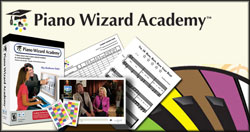In the fifth video of our Elements Of Music series, Music Wizard Founder Chris Salter discusses ways the understanding of language applies to learning music.
Music can be organized and self reflective, and that order can be called a language. Many parallels with human language can be found and leveraged to facilitate learning music.
a) Language is aural first, then written, then analyzed for structure (grammar). The structure is derived after the fact, but the verbal practice and expression, however unorthodox or illogical, is primary. Music is similar, and the theory and notation should not be considered primary, but learned after musical fluency and competence are there, the way we learn to speak a language then to recognize its written representation, and then its grammar, ideal learning means play first, then read what you already know how to play, then analyze what you played.
b) UNLIKE language, music is in its richest forms, played together and in harmony. Language is sequential, music is parallel, and while individual melodic or rhythmic lines or parts may be linear, and sequential, music combines to form moments of harmony and dissonance in parallel, giving another dimension to its expression and capacity to communicate.
c) UNLIKE language, music is therefore in its richest forms (harmonic) dependent on rhythm. Whereas you merely need to type in sequence to type correctly, in music, say piano, you need to hit the right keys, AT THE RIGHT TIME, or it is no longer "musical".
d) The first sounds a baby hears are rhythmic, i.e., the mother's heartbeat, the first images it sees and fixates on are round, mother's eyes and breasts. (The moon, flowers, the sun, logs of a tree are all among the first and primary circular patterns, and the moon and sun give the first cycles.) These patterns combine into music and emotion very quickly and instinctually. A rhythmic cycle is just a circle in the dimension of time.
e) Intonation probably came first as means of expression of emotional meaning, then discrete meanings of words separated from the expression, i.e, melody, then words.
[et_bloom_inline optin_id="optin_5"]


